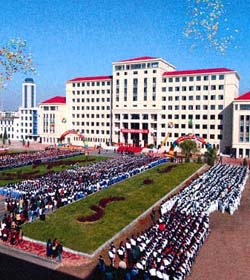2016年12月英语四级阅阅读理解练习及答案(十八)
2016-09-19 12:08:34pm
Questions 31 to 35 are based on the following passage:
Designing a lens can be compared to playing chess. In chess a player tries to trap his opponent’s king in a series of moves. In creating a lens a lens designer attempts to trap light by forcing all the rays arising from a single point in the subject to focus on a single point in the image, as a consequence of their passing through a series of transparent( 透明的) elements with precisely curved surfaces. Since in both cases the ultimate goal and the means by which it can be attained are known, one is tempted to think there will be a single best decision at any point along the way. The number of possible consequences flowing from any one decision is so large, however, as to bevirtually, if not actually, infinite. Therefore in lens design, as inchess, perfect solutions to a problem are beyond reach. Although this article will be concerned only with the design of photographic lenses, the same principles apply to all lenses.
The lens designer has one enormous advantage over the chess player: the designer is free to call on any available source of help to guide him through the staggering number of possibilities. Most of that help once came from mathematics and physics, but recently computer technology, information theory,chemistry, industrial engineering and psychophysics have all contributed to making the lens designer’s job immeasurably more productive. Some of the lenses on the market today were inconceivable a decade ago. Others whose design is as much as a century old can now be mass produced at low cost. With the development of automatic production methods, lenses are made by the millions, both out of glass and out of plastics. Today’s lenses are better than the best lenses used by the great photographers of the past.Moreover, their price may lower, in spite of the fact that 19th century craftsmen worked for only a few dollars a week and today’s lenses are more complex. The lens designer cannot fail to be grateful for the science and technology that have made his work easier and his creations more widely available, but he is also humbled: it is no longer practical for a fine photographic lens to be designed from beginning to end by a single human mind.
31.Lens design and chess playing are similar in that ____.
A) the final goal and the means by which it can be reached are known
B) perfect solutions to a problem can be found
C) any one decision at any point along the way to the goal can bring numerous possible results
D) both A and C
32.The final goal of designing a lens is ____.
A) to trap the opponent’s lenses
B) to focus light with lenses
C) to hand make lenses at low cost
D) to reflect light by means of curved surfaces
33.After the passage the author will talk about ____.
A) the principles of designing lenses
B) techniques of making contact lenses
C) the design of photographic lenses
D) styles of lenses
34.Which of the following words cannot be used to describe today’s lenses?
A) More delicate. B) Cheaper. C) Numerous. D) Unpopular.
35.Lens designers today ____.
A) have a large source of help to fall back on B) receive a low salary
C) are less respectable than those of the past D) are not decisive in the lens design
参考答案:
31.答案D。见文章第一段四至六句,相似之处在于最终目标以及达到目标的手段都是 明确的,只是在任一环节上所作的任何一项决定都可能导致无数个结果。
32.答案B。见文章第三句创造镜片时,设计者试图‘捕捉’光线,他们迫使源自物 体某个点的所有光线穿过一组曲度准确的透镜,结果光线集中在影像的一个点上。
33.答案C。第一段的最后一句说 this article will be concerned only with the design of photographic lenses,故C正确。contact lenses隐形眼镜
34.答案D。第二段第四句说另外一些其设计有百年之老的镜片现在可以大批量生产 且造价低廉。根据此句可推出现在的镜片还保持着传统,但并不能推出它们是不受欢迎 的。故答案是 D。
35.答案A。依据是第二段的第一句话。 B,C和D文章没谈到。decisive果断的。
以上就是查字典大学网为同学们带来的“2016年12月英语四级阅阅读理解练习及答案(十八)”内容了,希望看完能够带给大家一些力量,对同学的生活有所启示,更多内容在这里,请继续关注我们。
推荐文章
猜你喜欢
附近的人在看
推荐阅读
拓展阅读
院校推荐
猜你喜欢
办公室恋情恶果VS好处
90后求职女生吴丽春:“相信勇敢之后必有春天”
中国的社会保障改革亟须顶层设计
职场为人处世三大准则:爱岗敬业 不卑不亢 自信坦然
创业,会给职业生涯加分多少?
中国IT城市满意度排名
15个细节助你走向美好的职业生涯
中国国际形象最佳城市排名 上海居首
大学生利用过年前短短的十几天兼职
大学生如何弥补自身的求职劣势
彩虹族成职场白领新宠
高校“求职达人” 毕业即获50万年薪 做好职业规划
别把职业规划当成口头禅
2010全球城市排名中国七城市上榜 北京排名十五
新兴职业发展遇瓶颈 或"无地用武"或"有市无人"
大一小伙骑单车37天到拉萨 全程2166公里
关于主动性的三个小故事
职场白领热门电影推荐



